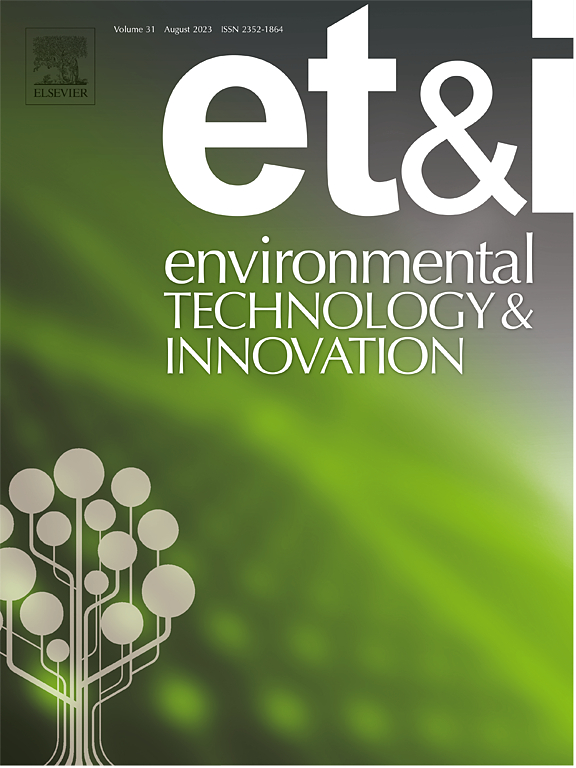基于Z-scheme的石墨烯/TiO2/MnO2杂化纳米材料的制备:在危险染料和抗菌还原中的双重应用
IF 6.7
2区 环境科学与生态学
Q1 BIOTECHNOLOGY & APPLIED MICROBIOLOGY
引用次数: 0
摘要
采用石墨烯/TiO2/MnO2 (GTM)杂化光催化剂,研究了亚甲基蓝(MB)染料的光催化降解效果。对MB染料的光催化降解性能表明,制备的GTM杂化光催化剂具有优异的活性,在紫外-可见光照射40 min内,降解效率达到97 %。值得注意的是,GTM杂化光催化剂的速率常数(k)为0.174 min⁻¹ ,超过了裸TiO2 (k = 0.030 min⁻¹)和MnO2 (k = 0.047 min⁻¹)光催化剂。长达10次循环的循环稳定性测试证实了GTM混合光催化剂的优异耐久性,保持了80% %的初始活性。羟基和超氧自由基在降解过程中起着重要作用,而异质结结构显著增强了电荷分离,进一步提高了光催化效率。GTM杂化物的光催化性能增强可归因于改进的载流子分离,增加的表面积以及2D/2D/1D异质结的形成。并采用琼脂孔扩散法对制备的光催化剂对肺炎克雷伯菌(KP)和金黄色葡萄球菌(SA)的抑菌活性进行了分析。结果表明,GTM对两种微生物均有较好的抑菌活性。这项研究有助于开发可持续的环境修复材料和工艺,符合绿色化学的原则,促进更清洁、更健康的环境。本文章由计算机程序翻译,如有差异,请以英文原文为准。
Facile preparation of Z-scheme based graphene/TiO2/MnO2 hybrid nanomaterial: A dual application in hazardous dye and antibacterial reduction
This study explores the photocatalytic degradation efficacy of methylene blue (MB) dye, a prevalent water pollutant, employing graphene/TiO2/MnO2 (GTM) hybrid photocatalyst. The photocatalytic degradation performance against MB dye revealed that the as-prepared GTM hybrid photocatalyst exhibited superior activity, achieving a degradation efficiency of 97 % within 40 min of UV–visible light irradiation. Notably, the GTM hybrid photocatalyst demonstrated a high-rate constant (k) of 0.174 min⁻¹ , surpassing that of the bare TiO2 (k = 0.030 min⁻¹) and MnO2 (k = 0.047 min⁻¹) photocatalysts. Cyclic stability tests up to ten cycles confirmed the excellent durability of the GTM hybrid photocatalyst, retaining 80 % of its initial activity. Hydroxyl and superoxide radicals play a significant role in the degradation process, while the heterojunction structure significantly enhances charge separation, further improving photocatalytic efficiency. The enhanced photocatalytic performance of the GTM hybrid can be attributed to the improved charge carrier separation, augmented surface area, and 2D/2D/1D heterojunction formation. Also, the antibacterial activity of the as-prepared photocatalyst was analyzed over Klebsiella pneumoniae (KP) and Staphylococcus aureus (SA) using the agar well diffusion method. The observed results show that the GTM has effective antibacterial activity against both microorganisms. This research contributes to developing sustainable materials and processes for environmental remediation, aligning with the principles of green chemistry and promoting a cleaner, healthier environment.
求助全文
通过发布文献求助,成功后即可免费获取论文全文。
去求助
来源期刊

Environmental Technology & Innovation
Environmental Science-General Environmental Science
CiteScore
14.00
自引率
4.20%
发文量
435
审稿时长
74 days
期刊介绍:
Environmental Technology & Innovation adopts a challenge-oriented approach to solutions by integrating natural sciences to promote a sustainable future. The journal aims to foster the creation and development of innovative products, technologies, and ideas that enhance the environment, with impacts across soil, air, water, and food in rural and urban areas.
As a platform for disseminating scientific evidence for environmental protection and sustainable development, the journal emphasizes fundamental science, methodologies, tools, techniques, and policy considerations. It emphasizes the importance of science and technology in environmental benefits, including smarter, cleaner technologies for environmental protection, more efficient resource processing methods, and the evidence supporting their effectiveness.
 求助内容:
求助内容: 应助结果提醒方式:
应助结果提醒方式:


